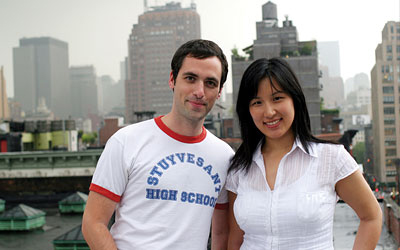Jonathan Solomon ’00 saw a void in the architectural press: Academic journals and consumer publications weren’t addressing the issues that he and other young architects were discussing. So with a group of fellow young architects, Solomon created a new journal, 306090: A Journal of Emergent Architecture + Design, to highlight the projects and ideas that were being ignored in the existing architectural press.
A third-generation architect, Solomon grew up thinking about design and its impact and speaking the language of architecture and design. “I’ve known pretty much since age 6 or so that architecture was something I wanted to do,” he says. “It’s like when you grow up in a household that speaks a second language. I’ve known forever that architecture is the language that I wanted to speak.” After receiving his degree in urban studies with a focus in architecture at Columbia, Solomon continued his studies at Princeton, earning a master’s in architecture.
During Solomon’s second year in his master’s program, he and classmate Jenny Ferng came up with the plan to start a journal that published student work. They wanted it to be more than a house organ for the architecture school, instead conceiving of something that could challenge and criticize the architectural establishment, including their own education. The first issue included the work of several young designers and a conversation with architectural critic Philip Nobel. After Ferng graduated, Solomon took 306090 to New York and incorporated it, bringing on new staff members, including architecture major Emily Abruzzo ’00. Partially funded with grants from the Richard H. Driehaus Foundation and the Graham Foundation for Advanced Studies in the Fine Arts, 306090 has a circulation of 2,000.
The first issue was launched with a simultaneous show at the Storefront for Art and Architecture, named “eMeRGenT” as a nod to the journal’s subtitle. A number of subsequent issues also have had a concurrent “eMeRGenT” show, designed as a way for contributors and readers to meet and to see the objects in the journal. The events have given 306090 more exposure and brought new and established designers together.
Solomon, Abruzzo and the other editors strive to create a mix of the new and old, finding fresh ways to look at traditional topics. Architect Michael Sorkin wrote about the possibility of an Olympics in the Bronx, which was followed by the work of five students who had developed models and proposals to put the plan into action. Another article explored Nathaniel Kahn’s documentary, My Architect, about his struggle to understand his father, Louis Kahn. Abruzzo says the editors would like to see more student work, maybe publishing “the very, very good competition entries that get lost when they don’t win.” Solomon is interested in working with “young people who are practicing in offices that nurture and appreciate their work, and also people whose offices are suppressing their work but are doing interesting work on the weekend.”
The theme for the third issue was “Collectives and Manifestoes.” Solomon wants to open a dialogue for architects and designers and exhorts his colleagues to join in. He jokes that his Columbia years were a great preparation, as “the best students are the troublemakers” and the Columbia education “can instill a very strong belief in making waves.” It was this belief in challenging the status quo, combined with his four years of editorial experience at Spectator, that led to the forming of 306090.
Distributed nationally through the Princeton Architectural Press, 306090 is available from bookstores, online booksellers, and from its Web site.
Originally published in Columbia College Today, July 2003

 In the fifth Princess Diaries book, Mia, a hilarious New Yorker who happens to be the princess of fictional Genovia, struggles with a citywide restaurant strike, turning 15, and trying to wrangle an invite to the prom. Laced with a smart-alecky feminism, the book, like totally gets the tone of precocious private-school nerds. Cabot pumps up the madcap plot with amusing pop-culture and highbrow references: Mia’s imperious, chain-smoking Grandmere has named her dog Rommel, a sly suggestion of how the dowager princess “has embraced the dark side…fully…But I guess even Darth Vader had his moments.” Picture Mia as a funnier (and more articulate) sister to Nancy Drew or the Baby Sitters Club.
In the fifth Princess Diaries book, Mia, a hilarious New Yorker who happens to be the princess of fictional Genovia, struggles with a citywide restaurant strike, turning 15, and trying to wrangle an invite to the prom. Laced with a smart-alecky feminism, the book, like totally gets the tone of precocious private-school nerds. Cabot pumps up the madcap plot with amusing pop-culture and highbrow references: Mia’s imperious, chain-smoking Grandmere has named her dog Rommel, a sly suggestion of how the dowager princess “has embraced the dark side…fully…But I guess even Darth Vader had his moments.” Picture Mia as a funnier (and more articulate) sister to Nancy Drew or the Baby Sitters Club. Martin Page’s hero, Antoine, thinks the great division in our world is between those who are smart and unhappy and those who are stupid and happy. Proving this premise is Antoine’s raison d’etre in Page’s attempt to write a satire of how society punishes the brilliant, How I Became Stupid.
Martin Page’s hero, Antoine, thinks the great division in our world is between those who are smart and unhappy and those who are stupid and happy. Proving this premise is Antoine’s raison d’etre in Page’s attempt to write a satire of how society punishes the brilliant, How I Became Stupid.